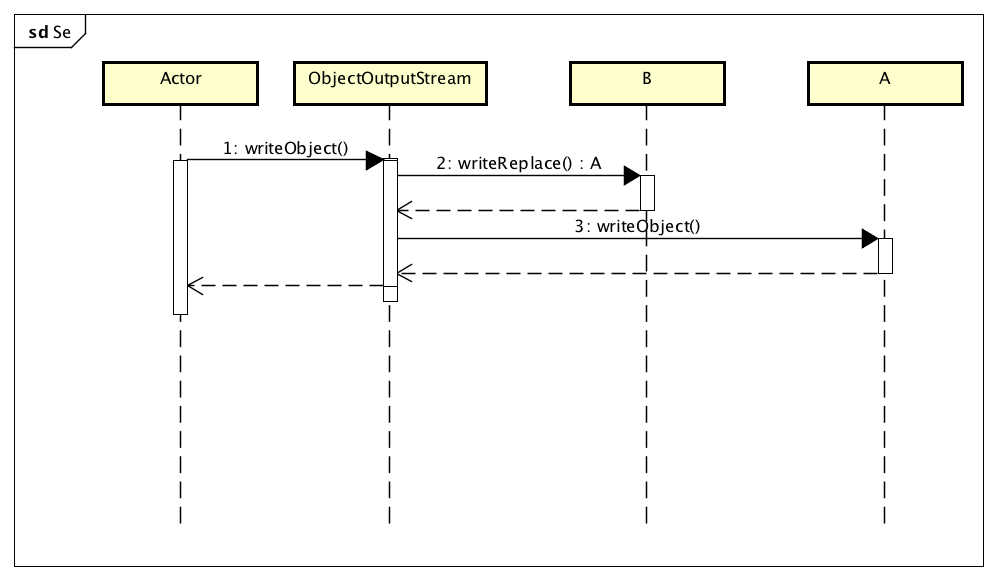通过测试代码分析序列化执行过程,通过本文可以理解writeObject,writeReplace方法的执行顺序,以及序列化执行的具体过程。
public class Author implements Serializable {
protected int id;
protected String username;
protected String password;
protected String email;
protected String bio;
protected Section favouriteSection;
public Author() {
this(-1, null, null, null, null, null);
}
public Author(Integer id, String username, String password, String email, String bio, Section section) {
this.id = id;
this.username = username;
this.password = password;
this.email = email;
this.bio = bio;
this.favouriteSection = section;
}
public Author(int id) {
this(id, null, null, null, null, null);
}
public void setId(int id) {
this.id = id;
}
public void setUsername(String username) {
this.username = username;
}
public void setPassword(String password) {
this.password = password;
}
public void setEmail(String email) {
this.email = email;
}
public void setBio(String bio) {
this.bio = bio;
}
public void setFavouriteSection(Section favouriteSection) {
this.favouriteSection = favouriteSection;
}
public int getId() {
return id;
}
public String getUsername() {
return username;
}
public String getPassword() {
return password;
}
public String getEmail() {
return email;
}
public String getBio() {
return bio;
}
public Section getFavouriteSection() {
return favouriteSection;
}
private void readObject(ObjectInputStream in) throws IOException, ClassNotFoundException {
System.out.println("readObject");
in.defaultReadObject();
}
private void writeObject(ObjectOutputStream out) throws IOException{
System.out.println("writeObject");
out.defaultWriteObject();
}
Object writeReplace() throws ObjectStreamException{
System.out.println("writeReplace");
Author replaced=new Author();
replaced.setId(123);
return replaced;
}
@Test
public void testSeria() throws Exception{
Author author=new Author();
author.setId(456);
Serializable result= deserialize(serialize((Serializable)author));
System.out.println(((Author)result).getId());
}
protected byte[] serialize(Serializable value) throws Exception {
ByteArrayOutputStream bos = new ByteArrayOutputStream();
ObjectOutputStream oos = new ObjectOutputStream(bos);
oos.writeObject(value);
oos.flush();
oos.close();
return bos.toByteArray();
}
protected Serializable deserialize(byte[] value) throws Exception {
ByteArrayInputStream bis = new ByteArrayInputStream(value);
ObjectInputStream ois = new ObjectInputStream(bis);
Serializable result = (Serializable) ois.readObject();
ois.close();
return result;
}
上面的测试代码的结果是什么呢?
writeReplace writeObject readObject 123
通过测试代码可以发现,序列化过程如下:

相关源码如下
public final void writeObject(Object obj) throws IOException {
if (enableOverride) {
writeObjectOverride(obj);
return;
}
try {
writeObject0(obj, false);
} catch (IOException ex) {
if (depth == 0) {
writeFatalException(ex);
}
throw ex;
}
}
private void writeObject0(Object obj, boolean unshared)
throws IOException
{
。。。。
for (;;) {
// REMIND: skip this check for strings/arrays?
Class<?> repCl;
desc = ObjectStreamClass.lookup(cl, true);
//如果存在writeReplace方法,调用需要序列化对象的writeReplace方法,如果返回对象不为null且writeReplace返回对象和原序列化对象类相同则退出循环
if (!desc.hasWriteReplaceMethod() ||
(obj = desc.invokeWriteReplace(obj)) == null ||
(repCl = obj.getClass()) == cl)
{
break;
}
cl = repCl;
}
。。。
// remaining cases
if (obj instanceof String) {
writeString((String) obj, unshared);
} else if (cl.isArray()) {
writeArray(obj, desc, unshared);
} else if (obj instanceof Enum) {
writeEnum((Enum<?>) obj, desc, unshared);
} else if (obj instanceof Serializable) { //如果实现了Serializable接口
writeOrdinaryObject(obj, desc, unshared);
} else {
if (extendedDebugInfo) {
throw new NotSerializableException(
cl.getName() + "\n" + debugInfoStack.toString());
} else {
throw new NotSerializableException(cl.getName());
}
}
} finally {
depth--;
bout.setBlockDataMode(oldMode);
}
}
private void writeOrdinaryObject(Object obj,
ObjectStreamClass desc,
boolean unshared)
throws IOException
{
。。。
try {
desc.checkSerialize();
bout.writeByte(TC_OBJECT);
writeClassDesc(desc, false);
handles.assign(unshared ? null : obj);
if (desc.isExternalizable() && !desc.isProxy()) {
writeExternalData((Externalizable) obj);
} else {//写序列化数据
writeSerialData(obj, desc);
}
} finally {
if (extendedDebugInfo) {
debugInfoStack.pop();
}
}
}
private void writeSerialData(Object obj, ObjectStreamClass desc)
throws IOException{
。。。
try {
curContext = new SerialCallbackContext(obj, slotDesc);
bout.setBlockDataMode(true);
//调用序列化对象的writeObject方法
slotDesc.invokeWriteObject(obj, this);
bout.setBlockDataMode(false);
bout.writeByte(TC_ENDBLOCKDATA);
} finally {
curContext.setUsed();
curContext = oldContext;
if (extendedDebugInfo) {
debugInfoStack.pop();
}
}
}
}